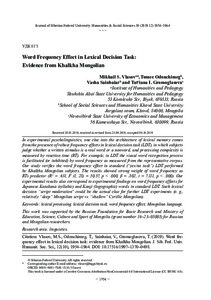Word Frequency Effect in Lexical Decision Task: Evidence from Khalkha Mongolian
Скачать файл:
URI (для ссылок/цитирований):
https://elib.sfu-kras.ru/handle/2311/126889Автор:
Vlasov, Mikhail S.
Odonchimeg, Tumee
Sainbaiar, Vasha
Gromoglasova, Tat‘iana I.
Власов, М. С.
Одончимэг, Т.
Саинбаяр, В.
Громогласова, Т. И.
Дата:
2019-10Журнал:
Журнал Сибирского федерального университета. Гуманитарные науки. Journal of Siberian Federal University. Humanities & Social Sciences;2019 12 (10)Аннотация:
In experimental psycholinguistics, one clue into the architecture of lexical memory comes from the presence of robust frequency effects in lexical decision task (LDT), in which subjects judge whether a written stimulus is a real word or a nonword, and processing complexity is measured by reaction time (RT). For example, in LDT the visual word recognition process is facilitated (or inhibited) by word frequency as measured from the representative corpus. Our study verifies the word frequency effect in standard (“yes/no task”) LDT performed by Khalkha Mongolian subjects. The results showed strong weight of word frequency as RTs predictor (R2 = .631, F (1, 28) = 50.57, p < .000, β = .802, t = 7.111, p < .000). Our experimental results also correspond to experimental findings on word frequency effects for Japanese Katakana (syllabic) and Kanji (logographic) words in standard LDT. Such lexical decision “script moderation” could be the actual clue for further LDT experiments (e. g., relatively “deep” Mongolian script vs. “shallow” Cyrillic Mongolian) В экспериментальной психолингвистике один из ключевых элементов моделирования
лексической памяти основывается на мощных эффектах частотности при выполнении заданий на лексическое решение (LDT), в которых субъекты оценивают, является ли письменный стимул реальным словом или несловом, а сложность обработки измеряется временем реакции (RT). Распознавание слов облегчается (или подавляется)
частотой их употребления в языке, измеренной по репрезентативному корпусу. Наше
исследование проверяет влияние эффекта частотности слов в стандартном тесте
LDT, выполненном носителями халха-монгольского
языка. Результаты подтвердили
значимость частотности слова как предиктора скорости распознавания слова (времени реакции) (R2 = 0,631, F (1, 28) = 50,57, p <.000, β = .802, t = 7.111, p <.000). Наши
экспериментальные результаты также соотносятся с результатами другого экспериментального исследования эффекта частотности на материале японских лексических единиц, написанных на катакане (слоговом письме) и кандзи (логографическом
письме) в стандартном тесте LDT. Данная модификация процесса лексического решения фактором письменности может стать актуальным вопросом для дальнейших
экспериментальных исследований (например, на материале слов на относительно
«глубоком» (с более слабыми буквенно-звуковыми
соответствиями) старомонгольском письме и слов на «поверхностном» (с более развитыми буквенно-звуковыми соответствиями) современном кириллическом монгольском письме
Коллекции:
Метаданные:
Показать полную информациюСвязанные материалы
Показаны похожие ресурсы по названию, автору или тематике.
-
Idiostyle Characteristics of Lexical Compatibility in the 19th-Сentury Prose: Ural Stylometric Project
Mukhin, Mikhail Yu.; Mukhin, Nikolai Yu.; Мухин, М. Ю.; Мухин, Н. Ю. (Сибирский федеральный университет. Siberian Federal University, 2020-12)The article presents the project of the Ural Federal University scientists connected with the formalized study of lexical compatibility in Russian classical prose of the 19th century. The study aims to identify idiostylistic ... -
Comparative and Historical Aspect of Yakut Vocabulary of Common Names of Animal Body Parts
Malysheva, Ninel V.; Bozhedonova, Alla E.; Vasilyeva, Alina P.; Малышева, Н.В.; Божедонова, А.Е.; Васильева, А.П. (Сибирский федеральный университет. Siberian Federal University, 2018)The historical stage of the development of the Turkic languages, their interconnection with the languages of the Mongolian and Tungusic group and with other unrelated languages, the history of the migration of the Turkic ... -
Social Contacts of Migrant Women in the Context of Their Linguocultural Orientations (Case of the Republic of Tatarstan)
Titova, Tatiana A.; Vyatchina, Maria V.; Титова, Т.А.; Вятчина, М.В. (Сибирский федеральный университет. Siberian Federal University, 2016-04)The article is devoted to the study of linguocultural competences of migrant women from Central Asia in the Republic of Tatarstan. The analyzed materials were obtained using mass sociological survey methods, as well as ... -
Chinese-English Retour: Analysing the Impact of Language Errors
AiLing Zhang, Irene; Bailey, Matthew; Айлин Чжан, Ирэн; Бэйли, Мэттью (Сибирский федеральный университет. Siberian Federal University, 2015-12)The chronic shortage of native English speakers who are competent in Chinese has made it imperative that native Chinese speakers who have been professionally trained to be interpreters work bidirectionally between Chinese ... -
Лексические заимствования: лингвистический и лингводидактический аспекты
Тарев, Б.В.; Tarev, Boris V. (Сибирский федеральный университет. Siberian Federal University., 2012-07)This article is devoted to the study of borrowed lexis penetration in the recipient language. The author represents the methods of loan words analysis and their usage in the process of foreign-language communication. The ...

